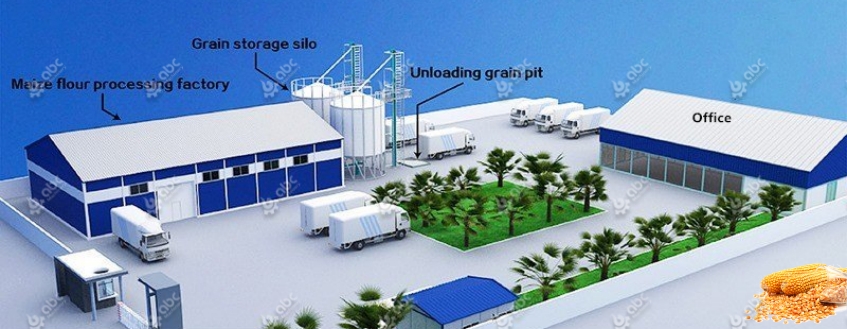
Large Industrial Corn Mill Plant Project Design Guide
The corn mill industry has witnessed steady growth, with global industrial corn processing capacity surpassing 150 million tons per year as of 2024. The demand for industrial corn mill plant operations continues to rise, driven by expanding applications in food, feed, bioethanol, and starch production.
North America and Asia account for nearly 65% of the total industrial output, while Africa shows an annual growth rate exceeding 8% due to rapid industrialization and infrastructure investment. Large-scale corn milling provides economies of scale, reducing per-ton processing costs by 15–20% compared to small mills.
Collaborate with our engineering experts to capture the expanding global corn milling demand through tailored plant solutions.
Designing an industrial corn mill plant requires a structured project planning process encompassing feasibility, capacity targets, site selection, layout, and compliance with safety and environmental standards.
A thorough feasibility study evaluates raw material supply, logistics, and market access. Typical industrial mills operate between 80–300 tons per day (TPD). A 200 TPD plant, for instance, requires an average footprint of 8,000–10,000 m² and annual operating costs of around USD 1.2 million.
Ideal corn flour mill plant sites selection should provide reliable electricity (minimum 2 MW), water supply (50–70 m³/day), and proximity to maize-growing regions within 150 km to minimize logistics costs. Accessibility to export ports or domestic distribution hubs significantly enhances competitiveness.

Simple Corn Flour Mill Plant Layout Design
Efficient corn mill plant layout design ensures smooth material flow and minimizes cross-contamination. Modern layouts typically separate raw material intake, processing, and packaging zones with dedicated dust extraction systems and ATEX-certified safety features.
| Key Planning Element | Recommended Range or Standard |
|---|---|
| Capacity Range | 80–300 TPD |
| Land Area | 8,000–12,000 m² |
| Power Requirement | 2–4 MW |
| Water Consumption | 50–70 m³/day |
| Construction Period | 10–14 months |
Compliance with ISO 50001 (energy management) and ISO 14001 (environmental management) standards ensures regulatory alignment and long-term sustainability. Dust emission levels should be controlled below 20 mg/Nm³, and wastewater should meet COD standards under 100 mg/L.
Power stability, waste management, and logistics are essential design considerations. Plants integrating renewable power or heat recovery systems can save up to 12% of energy costs annually. Incorporating vertical storage silos with automated conveyor systems also reduces material handling time by 30%.
Optimizing the layout for accessibility, expansion, and compliance improves both productivity and safety outcomes. Get your tailored industrial corn mill project design plan—connect with our engineering consultants today.
A typical corn milling process involves five core stages: cleaning, breaking, grinding, sieving, and packaging. Each stage demands specialized machinery to ensure consistent particle size and yield.

Corn Flour Mill Process Equipment in Large Factory
The cleaning stage removes impurities using air separators and magnetic systems with 99.5% efficiency. Hammer mills and roller mills handle the grinding phase, achieving a production rate of 6–10 tons/hour per line. Sieving efficiency can reach 97%, aided by vibration control systems.
Automation through PLC and NIR (Near-Infrared Reflectance) systems enables real-time moisture and quality monitoring. Advanced automated corn processing systems reduce human error by up to 40% and enhance yield consistency.
Well-integrated machinery improves uptime and minimizes waste, ensuring continuous 24/7 industrial operation.
Enhance your production efficiency with a customized industrial corn mill equipment setup designed for your specific output goals.
Setting up an industrial corn mill plant requires capital investments ranging from USD 3 million to USD 12 million, depending on scale and automation. Equipment accounts for 45–55% of total costs, followed by construction (25%) and utilities (15%).
Operational costs typically average USD 60–80 per ton, with energy consumption around 65–75 kWh/ton. Plants optimizing resource use and implementing energy recovery systems can shorten payback periods from 6 years to 4.5 years.
Efficient ROI (Return on Investment) analysis must factor in output quality, energy savings, and market access. Automation upgrades and preventive maintenance strategies can increase net profitability by 8–12% annually.
Precise cost forecasting and long-term maintenance strategies define the financial sustainability of a corn mill investment.
Partner with us to build a cost-efficient corn mill operation and maximize your project ROI.
A well-planned corn mill project not only ensures optimized production efficiency but also long-term operational reliability. Through strategic design, equipment integration, and sustainable management, an industrial corn mill plant becomes a cornerstone of modern agro-industrial development.